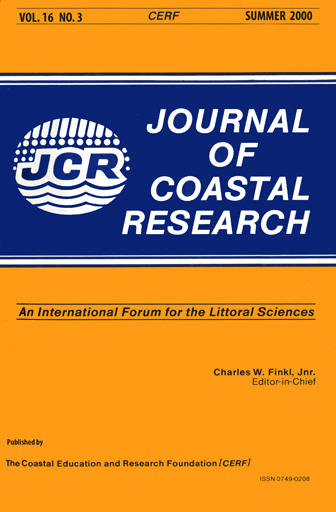Coastal Erosion, Processes and Rates: An Historical Study of the Gironde Coastline, Southwestern France
Keywords:
Longshore drift, sedimentary budget, sea defencesAbstract
The macrotidal (2-5 m range) Gironde coast, situated to the south of the Gironde estuary, is dominated by NW swell. The prominent cape Pointe de la Negade separates two linear sections of this coastline, with different orientations and different dynamic settings: a northern section, dominated by a maximum resultant northerly longshore drift (400,000 m3/yr); and the southern section, by a 630,000 m3/yr southerly drift.
A synthesis of numerous studies allows erosion over (at least) the past 37 years to be estimated; for certain sections for the past 200 years. The average rate of erosion decreases on both sides of the Pointe de la Negade, where it reached its maximum between 1957-1994 (7.3 m/yr). The northern section, protected by dykes and sea defences between the estuary mouth at Pointe de Grave and Soulac, has been stabilised. Today, only the limited area of the Huttes is not protected and is subjected to erosion of 9.6 m/yr; it is a area of great concern. To the south, the average rate of erosion decreases rapidly-it reached 0.4 m/year in Montalivet-and then was relatively constant around 1 m/year as far as the Grand-Crohot. The extremity of the Cap-Ferret spit has been generally accreting to seawards; it has also extended to the south, for the past 200 years. Since 1970, the tip of the spit has undergone erosion.
Erosion of the Gironde coast results from a sedimentary budget in deficit by some 350,000 m3/yr escaping northward (the difference between the northerly longshore drift (400,000 m3/yr) and 50,000 m3yr retained in the system by the process of erosion/accretion of the Huttes beach and St Nicolas sandbank) and 630,000 m3yr transported toward the south. Aeolian loss appears minimal and offshore loss, due to relative sea-level rise, is estimated to be between 600,000 and 900,000 m3/yr. The system receives no fluvial supply of sand and the primary source of sediment originates from coastal erosion, mobilised by longshore drift. Total sediment loss for the Gironde coast ranges between 1,580,000 and 1,880,000 m3/yr; this explains the average erosion rate, of between 1 and 2 m/yr. Whilst the longshore transport is quite well known, the onshore-offshore movements, especially those caused by the present-day sea level rise and/or aeolian action, are still poorly understood and require further investigation.


